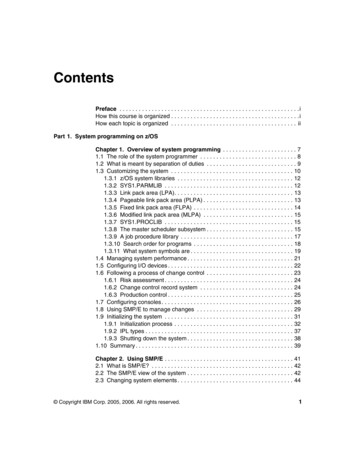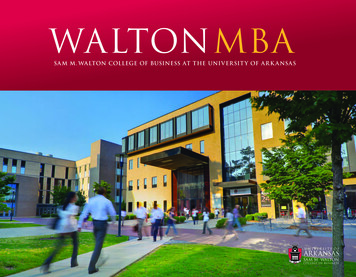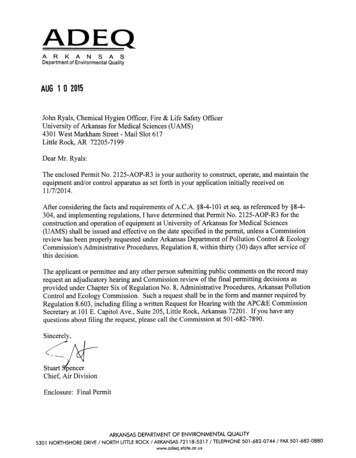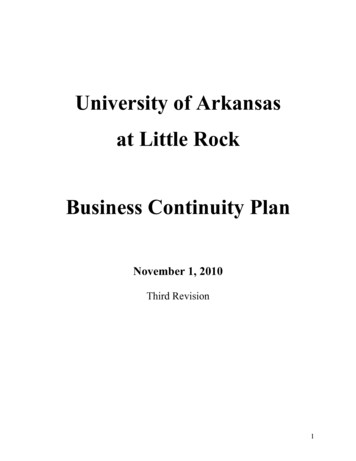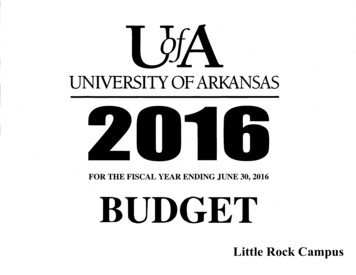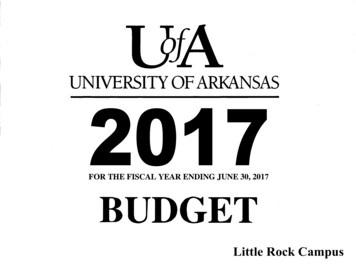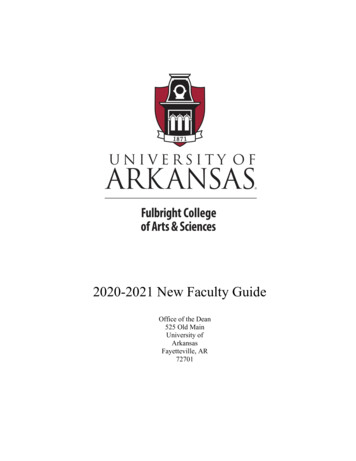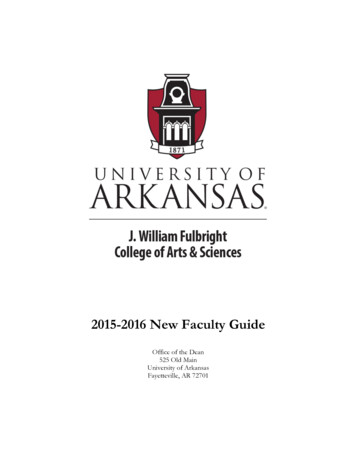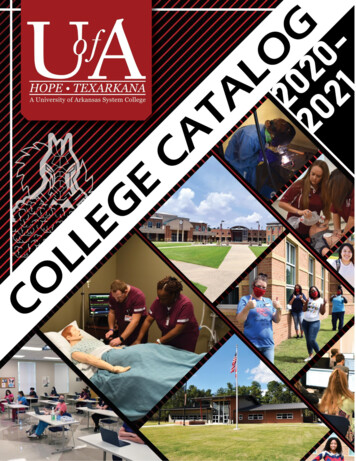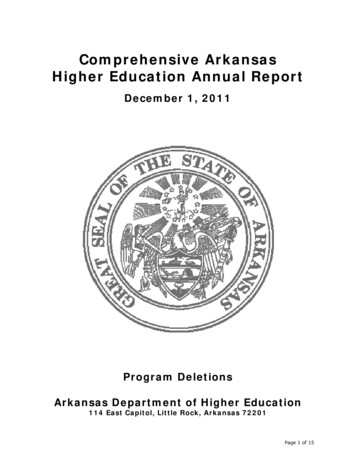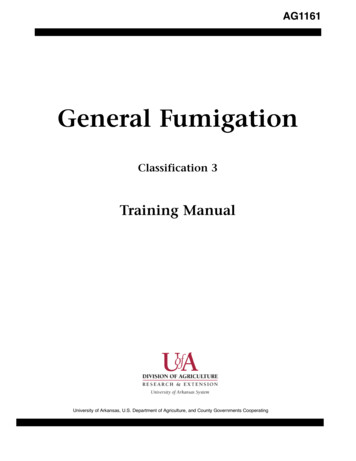
Transcription
AG1161General FumigationClassification 3Training ManualUniversity of Arkansas, U.S. Department of Agriculture, and County Governments Cooperating
Edited byDr. John D. Hopkins, Associate Professor and Extension Entomologist,University of Arkansas Division of Agriculture.Dr. Donald R. Johnson, Professor Emeritus, Extensin Entomologist, andPest Management Section Leader with the University of Arkansas, Divisionof Agriculture (Retires).
PrefaceThis manual provides information for the Arkansas commercial pesticide applicator wishing tobecome certified in General Fumigation – Classification 3. To become a certified applicator in this cate gory, a candidate must pass both a general standards exam and an examination based primarily on thematerial presented in this manual and (Circular 6) Arkansas Pest Control Law (act 488 of 1975, asamended). Information covered in the general standards examination is contained in “A Guide forPrivate and Commercial Applicators: Applying Pesticides Correctly.” Refer to (Circular 6) Arkansas PestControl Law (act 488 of 1975, as amended) for specific requirements. The Arkansas State Plant Boardadministers the examinations. Up-to-date study materials can be obtained from the Arkansas StatePlant Board, #1 Natural Resources Drive (P.O. Box 1069), Little Rock, AR 72203-1069, phone (501) 225 1598. Additional study information may be obtained from the University of Arkansas CooperativeExtension Service, the pesticide label, current publications on the subject, pesticide distributors, andmanufacturers.AcknowledgmentsInformation accumulates from direct observations, scientific literature, and anecdotes from others.Information from these sources blurs together quickly, and consequently, unique ideas are rare in society.Credit for sources of information on urban pest control and management must go to:Land Grant University extension and research workers, most entomologists, who pioneered thiswork, those who kept training and research alive during the period when the success of syntheticorganic pesticides preempted nearly all but control evaluations from the 1940s to the 1960s, andthose who persist today; pest control industry workers who held training sessions nationally, region ally, and locally where information was disseminated among the experienced and provided to theinexperienced; Environmental Protection Agency personnel who molded modern training and influ enced the need for national uniformity in training requirements; state regulatory personnel whocooperated with universities and industry and who strongly emphasized the importance of training;and the few textbook authors in the United States and England who compiled the reference data inthe understandable and usable form that allows urban pest management practitioners to beprofessionals.This manual has been adapted from commercial applicator certification training manuals for “Fumigation” and “Fumigation ofSoil and Agricultural Products” primarily developed by the Virginia Cooperative Extension, Virginia PolytechnicInstitute and State University, with information also from Oklahoma Cooperative Extension Service, Division of AgriculturalSciences and Natural Resources, Oklahoma State University; and University of Nebraska Cooperative Extension, University ofNebraska-Lincoln.3
Table of ContentsPage No.Page No. . . . . . . . . . . . . . . . . .7Learning Objectives . . . . . . . . . . . . . . . . . . . . . . .7Unit 3. Characteristics andEffects of Fumigants . . . . . . . . . . . . . . .53Terms to Know . . . . . . . . . . . . . . . . . . . . . . . . . . .7Learning Objectives . . . . . . . . . . . . . . . . . . . . . .53What Is a Fumigant? . . . . . . . . . . . . . . . . . . . . . .7Terms to Know . . . . . . . . . . . . . . . . . . . . . . . . . .53Scope of This Manual . . . . . . . . . . . . . . . . . . . . .8Characteristics of Fumigants . . . . . . . . . . . . . .54Unit 1. IntroductionThe Fumigation Manual . . . . . . . . . . . . . . . . . . .8Integrated Pest Management (IPM)and Decision-Making . . . . . . . . . . . . . . . . . . . . . .9Unit 2. Pest Identification,Biology and Management . . . . . . . . . .12Learning Objectives . . . . . . . . . . . . . . . . . . . . . .12Factors That Affect Fumigation of RawAgricultural Products . . . . . . . . . . . . . . . . . . . .57Factors That Affect Soil Fumigation . . . . . . . .61Unit 4. Pest ManagementOptions . . . . . . . . . . . . . . . . . . . . . . . . . . . . . .66Terms to Know . . . . . . . . . . . . . . . . . . . . . . . . . .12Learning Objectives . . . . . . . . . . . . . . . . . . . . . .66Who “Dunnit”? . . . . . . . . . . . . . . . . . . . . . . . . . .14Terms to Know . . . . . . . . . . . . . . . . . . . . . . . . . .66Pests of Stored Products . . . . . . . . . . . . . . .14IPM and Decision Making . . . . . . . . . . . . . . . . .67Pests of Raw Agricultural Products . . . . . .16Pathogens and Pests in Soil . . . . . . . . . . . . . . .77Common Pest Descriptions . . . . . . . . . . . . . . . .17Moth Pests . . . . . . . . . . . . . . . . . . . . . . . . . .17Unit 5. Methods of Fumigation . . . . .81Beetle Pests . . . . . . . . . . . . . . . . . . . . . . . . .21Learning Objectives . . . . . . . . . . . . . . . . . . . . . .81Other Pests . . . . . . . . . . . . . . . . . . . . . . . . .27Pests of Wood . . . . . . . . . . . . . . . . . . . . . . . . . . .30Termites . . . . . . . . . . . . . . . . . . . . . . . . . . . .30Beetles . . . . . . . . . . . . . . . . . . . . . . . . . . . . .32Miscellaneous Pests . . . . . . . . . . . . . . . . . . . . . .35Bed Bugs . . . . . . . . . . . . . . . . . . . . . . . . . . .35Terms to Know . . . . . . . . . . . . . . . . . . . . . . . . . .81Fumigation Methods . . . . . . . . . . . . . . . . . . . . .82Vault Fumigation . . . . . . . . . . . . . . . . . . . .83Tarpaulin Fumigation . . . . . . . . . . . . . . . . .88Spot (Local) Fumigation . . . . . . . . . . . . . . .91Cockroaches . . . . . . . . . . . . . . . . . . . . . . . . .35Aeration After Fumigation . . . . . . . . . . . . . . . .92Rodents . . . . . . . . . . . . . . . . . . . . . . . . . . . .38Factors Affecting Aeration Time . . . . . . . . .92Pathogens and Pests in Soil . . . . . . . . . . . . . . .40Aeration Procedures . . . . . . . . . . . . . . . . . .93Nematode Pests . . . . . . . . . . . . . . . . . . . . . .40Fumigation Methods – Soil . . . . . . . . . . . . . . . .97Plant Diseases . . . . . . . . . . . . . . . . . . . . . . .41Fumigant Movement Through Soil . . . . . .97Weeds . . . . . . . . . . . . . . . . . . . . . . . . . . . . . .43Formulations of Soil Fumigants . . . . . . . . .97Insect Pests . . . . . . . . . . . . . . . . . . . . . . . . .44Application and Containment ofSoil Fumigants . . . . . . . . . . . . . . . . . . . . . . .97Monitoring and Sampling inRaw Agricultural Products and Soil . . . . . . . . .48Methods of Soil Fumigation . . . . . . . . . . . .98Detecting Pest Problems –Raw Products . . . . . . . . . . . . . . . . . . . . . . . .48Soil Aeration . . . . . . . . . . . . . . . . . . . . . . .100Detecting Pest Problems – Soil . . . . . . . . .49Factors Affecting Soil Aeration . . . . . . . . .1015
Page No.Page No.Equipment Calibration . . . . . . . . . . . . . . . . . .102Self-Contained BreathingApparatus (SCBA) . . . . . . . . . . . . . . . . . . .125Useful Information for Calibration . . . . .102Equipment Calibration –Soil Injection . . . . . . . . . . . . . . . . . . . . . . .102Supplied-Air Respirators (SAR) . . . . . . . .125Air-Purifying Respirators . . . . . . . . . . . . .126Equipment Calibration –Chemigation . . . . . . . . . . . . . . . . . . . . . . . .105Care of RespiratoryProtection Equipment . . . . . . . . . . . . . . . . . . .127Test Your Knowledge . . . . . . . . . . . . . . . . .107Fitting and Testing the Respirator . . . . . .127Use of Respiratory Protection Equipment . . .128Unit 6. Public, Personal andEnvironmental Safety . . . . . . . . . . . . .110Gas Detection Equipment . . . . . . . . . . . . . . . .129Other Protection Equipment . . . . . . . . . . . . . .131Learning Objectives . . . . . . . . . . . . . . . . . . . . .110Terms to Know . . . . . . . . . . . . . . . . . . . . . . . . .110Unit 8. Common FumigantsProtecting the Publicand the Environment . . . . . . . . . . . . . . . . . . .111Learning Objectives . . . . . . . . . . . . . . . . . . . . .134Read the Label Information . . . . . . . . . . .111. . . . . . .134Terms to Know . . . . . . . . . . . . . . . . . . . . . . . . .134Common Fumigants . . . . . . . . . . . . . . . . . . . .135Signage for Fumigated Areas . . . . . . . . . .112Disclaimer . . . . . . . . . . . . . . . . . . . . . . . . .135Monitoring for the Fumigant . . . . . . . . . .112Sulfuryl Fluoride . . . . . . . . . . . . . . . . . . . .135Transporting Fumigants . . . . . . . . . . . . . .1121,3-Dichloropropene . . . . . . . . . . . . . . . . .137Storage and Disposal of Fumigants . . . . .113Chloropicrin . . . . . . . . . . . . . . . . . . . . . . . .139Tolerance Levels . . . . . . . . . . . . . . . . . . . .113Controlled Atmospheres (CAs) . . . . . . . . . . . .141Proper Aeration . . . . . . . . . . . . . . . . . . . . .113Carbon Dioxide . . . . . . . . . . . . . . . . . . . . .141Preparation and Planning . . . . . . . . . . . .113Dazomet . . . . . . . . . . . . . . . . . . . . . . . . . . .143Personal Safety . . . . . . . . . . . . . . . . . . . . .113Metam Sodium . . . . . . . . . . . . . . . . . . . . .144First Aid for Fumigant Poisoning . . . . . . .119Methyl Bromide . . . . . . . . . . . . . . . . . . . . .147Test Your Knowledge . . . . . . . . . . . . . . . . . . . .122Phosphine . . . . . . . . . . . . . . . . . . . . . . . . . .151Unit 7. Safety Equipment . . . . . . . . . .124Learning Objectives . . . . . . . . . . . . . . . . . . . . .124Appendix A.Sample Safety Checklists. . . . . . . . .158Terms to Know . . . . . . . . . . . . . . . . . . . . . . . . .124Respiratory Equipment Protection . . . . . . . . .124Atmosphere-Supplying Respirators . . . . .125Appendix B.Volume Calculations. . . . . . . . . . . . . .169The pesticide information presented in this publication was current with federal and state regulations at the time of printing. The useris responsible for determining that the intended use is consistent with the label of the product being used. Use pesticides safely.Read and follow label directions. The information given herein is for educational purposes only. Reference to commercial products ortrade names is made with the understanding that no discrimination is intended and no endorsement by the Cooperative ExtensionService is implied.6
Unit 1. IntroductionLearning ObjectivesAfter reading this unit, the reader will beable to: Explain what fumigants are and how theywork.Understand the scope of this manual.Summarize the contents of this manual.The introduction describes the importanceof fumigation. Although they are highly toxic,fumigants are often the best and only way tocontrol pests in soil and raw commodities.They are also important for quarantinebetween states and between countries. Byreading this unit, you will learn whatfumigants are and how they work. This unitwill outline the scope and purpose of thismanual. It will also describe each unit and thetype of information included.Terms to KnowAeration – The process of replacing fumigantcontaining air or water with fresh air and/orwater that contains little or no fumigant.Aeration must follow all fumigation operations.Tilth – The physical condition of soil thatdetermines the ease with which it can be tilledor cultivated and its suitability for seedgermination and plant growth.The earliest use of fumigants as pesticidesdates back to 2500 BC. At that time, peopleburned sulfur to control insects and mites.Today, we use fumigants to control insects,rodents and other pests. We rely on thesechemicals to treat grain bins, boxcars and evensoil. Fumigation is one of the quickest and mosteffective ways to eliminate pests from storedgrain, tobacco and sometimes homes. We alsouse fumigation in quarantine. It helps toprevent pests from traveling from one locationto another.Unfortunately, fumigants are some of themost toxic pesticides in the world. Even smallamounts can kill nontarget insects, animals andpeople. Fumigants are often fast acting, odorlessand invisible. Many are highly flammable. Forthese reasons, fumigators require more trainingand skill than do many other pest controloperators. Skill and training are critical forsafe application.Commodities – Items produced for trade orcommerce.What Is a Fumigant?Fumigant – A pesticide that is a gas, or formsa gas, when applied. In a high enoughconcentration, this gas (vapor) has pesticidalaction.A fumigant is a gas with pesticidal action.Fumigants are gases, or form gases, afterapplication. In a high enough concentration, afumigant can kill insects and other pests.Fumigants may be odorless, and usually cannotbe seen.Infestation – A pest population that grows solarge it becomes harmful or unpleasant.Integrated Pest Management – A pestmanagement system that uses all appropriatestrategies to reduce pest populations.Molecules – The smallest particle of asubstance that retains all the properties of thatsubstance.Pest – Any living thing that is undesirable orcauses harm to people or the environment. Anorganism may be a pest in one place but not inanother; for example, termites in a house vs.those that recycle dead trees in a forest.People often mistake smokes, fogs, mists andother aerosols for fumigants. However, thesepesticides produce relatively large particles ordroplets that are very different from fumigants.They are not true fumigants because they arenot gases.As a gas, a fumigant consists of separatemolecules that are much smaller than thedroplets of a fog or mist. Fumigants canpenetrate even seemingly solid items like brick,concrete and wood. However, these items are notas solid as they appear. In a magnified view, it is7
possible to see the molecules of wood and thespaces between them. Fumigant moleculesactually move between the wood molecules toreach the pests. Because fumigants penetrate sowell, they must be confined in an enclosed space.As soon as a fumigant escapes from anenclosure, its effectiveness is lost.NOTE: Fumigants provide no residualprotection. Once a commodity has been treatedand aerated, new pests can attack at any time.Scope of This ManualFumigation is used to treat a wide range ofpests in many locations. It is most oftenreserved for pests that live in hard-to-reachareas such as soil, stored grain or wood.This manual, General Fumigation, coversfumigation of structures, soil and agriculturalsites, such as crop fields, that are used for theproduction of agricultural products. It alsodeals with the fumigation of food and rawcommodities. Raw commodities include wholegrains, tobacco, nuts, raw logs and otherunprocessed products.The Fumigation ManualThe purpose of this manual is to providebasic information to help you fumigate safely andeffectively. It starts by describing the major (themost common and the most damaging) pests ofstructures, soil, food and raw commodities inArkansas. While the list is long, it is by no meanscomplete. Professional organizations, universities,industries and government agencies producedetailed field guides and other pest identificationreferences. These sources will help you learnmore about the pests described here. They willalso describe pests not included in this manual.Many things can be pests. Insects, mites,nematodes, pathogens and rodents can allharm structures, soil-grown crops and storedcommodities. This manual will focus on pests thatare commonly controlled by fumigation. You willlearn about their life cycles and what to look forwhen scouting. This manual also describes themost vulnerable stage (s) of common pests andthe best time(s) for efficient and effective control.8You will also learn about fumigants.Fumigants have many characteristics that canaffect how well they work. These include boilingpoint, molecular weight, water solubility andflammability. External factors such astemperature and humidity can also affectperformance. When fumigating soil, applicationtechniques and soil features such as tilth andtexture can affect the success of your treatment.This manual will describe these factors and helpyou understand how different fumigants willperform in different situations.This manual describes the principles ofIntegrated Pest Management (IPM). It explainswhen and how fumigation fits into a well-plannedIPM program. You will also learn several ways tocontrol pest and disease problems withoutfumigation. These alternatives to fumigation maybe cultural, biological or chemical. By using acombination of methods, you may often achievethe best control.This manual will introduce you to a range offumigation methods and equipment. You willlearn basic techniques used to treat soil and rawcommodities. Each method has its pros and cons.You will learn how to select a treatment methodbased on the pest, the item or type of soil infestedand the severity of the infestation. Duringfumigation, problems often arise. You will learnhow to prevent these problems, and how tohandle them if they do develop.Aeration must follow all types of fumigation.For indoor treatments, aeration introduces freshair to dilute and remove fumigant-filled air. Forsoil treatments, aeration allows the fumigant toescape from the soil and/or water in the soil, untillittle or no fumigant is left. Proper aeration is keyto safe fumigation. Procedures for aeration varywith the fumigant, the item or type of soil treatedand the conditions in the treatment area. Thismanual will describe aeration techniques for avariety of situations.Pest control decision-making will beaddressed throughout this manual. Beforefumigating, answer the following questions: Is the problem actually caused by a pest?If so, what pest?What effective and affordable control optionsare available?
Is the problem severe enough to warrantfumigation?Is the pest in a vulnerable stage in its lifecycle?A good planner makes careful records of pestproblems: when and where the problem occurred,solutions and results. He or she also learns howto prevent future problems.Fumigants are the most hazardous of allpesticides. Small amounts of many fumigants cancause serious illness or death. This manualdescribes ways to protect the public, your co workers and yourself from exposure. It providessafety checklists for all stages of fumigation. Youwill learn about special tools and first aidtechniques.Respirators and gas detectorss are two of themost important safety tools in fumigation.Respirators provide clean air to workers duringfumigation and aeration. Gas detectors monitorand record gas levels before, during and aftertreatment. This manual will describe severalmodels of each device. You will learn how to selectthe best model for your situation. You will alsolearn how to inspect, maintain and use thisequipment properly.Finally, this manual will discuss commonfumigants used to treat structures, soil, foodproducts and raw commodities.Integrated PestManagement (IPM) andDecision-Makingchemical management methods. IPM is dedicatedto removing causes rather than simply treatingsymptoms. The goals of an IPM program are toreduce pest numbers to an acceptable level in away that is practical, cost-effective and safe forpeople and the environment.The first strategy of an IPM program isprevention. Prevention relies on sanitation,proper storage and the condition of thecommodity before and after it is placed intostorage. You may be able to exclude pests orprovide them with unsuitable living conditions.Preventing a pest problem before it occurs savestime and money.There are many ways to control pests thatinfest structures, wood and stored products. Yourjob is to select the best method for the situationat hand. Pesticides and other control methodsoften pr
Pest Management Section Leader with the University of Arkansas, Division of Agriculture (Retires). Preface . This manual provides information for the Arkansas commercial pesticide applicator wishing to become certified in General Fumigation – Classif
